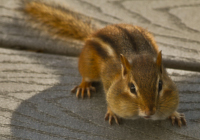 These cute little creatures are extremely common in home
landscapes. Often you see them scurrying around beneath
the bird feeder with their cheeks stuffed with seed.
They can be nice to watch but can cause a certain amount
of damage or problems in the garden.
These cute little creatures are extremely common in home
landscapes. Often you see them scurrying around beneath
the bird feeder with their cheeks stuffed with seed.
They can be nice to watch but can cause a certain amount
of damage or problems in the garden.
When you follow a chipmunk, it will eventually disappear
down a hole in the ground. This may lead into a tunnel
that can be up to 30 feet long. There will be no soil
piled up at the opening because the chipmunk wisely
gathers the excess soil into its mouth and scatters it
elsewhere.
Chipmunks usually have two generations per year and can
quickly build up numbers in your garden. To feed these
broods, they gather food such as seeds, berries, nuts,
insects and mushrooms throughout the season. This may
involve knocking down small plants in order to gather
the seeds on top.
Unlike
woodchucks, chipmunks do not hibernate during the
cold weather. They just slow down a lot and may become
active on warm, sunny days of the winter.
Chipmunks feed on our plants and bulbs, tunnel under
sidewalks and porches and can occassionally come into the house
through small openings.



